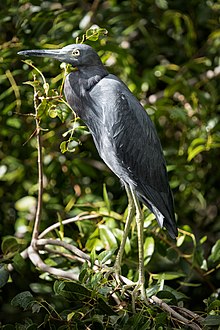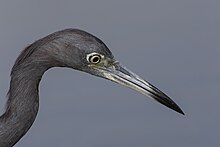Little blue heron
| Little blue heron | |
|---|---|

| |
| Adult little blue heron in Cananeia, São Paulo , Brazil
| |
| Scientific classification | |
| Domain: | Eukaryota |
| Kingdom: | Animalia |
| Phylum: | Chordata |
| Class: | Aves |
| Order: | Pelecaniformes |
| Family: | Ardeidae |
| Genus: | Egretta |
| Species: | E. caerulea
|
| Binomial name | |
| Egretta caerulea | |

| |
| Distribution of Egretta caerulea: breeding non-breeding year-round migration
| |
| Synonyms | |
|
Ardea caerulea Linnaeus, 1758 | |

The little blue heron[note 1] (Egretta caerulea) is a small heron of the genus Egretta. It is a small, darkly colored heron with a two-toned bill. Juveniles are entirely white, bearing resemblance to the snowy egret. During the breeding season, adults develop different coloration on the head, legs, and feet.
They have a
Nesting behaviors are documented by numerous sources. The adults build nests in trees, in colonies with other bird species. The number of eggs laid varies from place to place. The young mature quickly, requiring little attention from adults after about nineteen days of age. Both young and adults are sometimes preyed on by other species. Adults hunt fish, crabs, and other small animals. As with clutch sizes, diet can vary regionally.
The population of E. caerulea is declining. Many possible reasons for this have been proposed. Exposure to heavy metals has been found to have detrimental effects on young birds.
Taxonomy
The little blue heron is part of the
Young birds found in a little blue heron nest in
Description
Males and females have the same coloration. The adults are darkly colored, with purple-maroon heads and blue bodies. During the breeding season, their heads turn dark red. They have two-toned bills, which are a light blue at the base, with black tips. Their eyes are yellow and their legs are greenish. Juveniles are almost completely white, although the upper primaries are somewhat dark in color. Like adults, their bills are two-toned. Immature birds transitioning from the juvenile to adult phase have a combination of light and dark feathers. Both sexes are about 56–74 centimetres (22–29 in), with a wingspan of 100–105 centimetres (39–41 in). They weigh about 397 grams (14.0 oz).[7][8]
The lores, which are normally a dull green become a shade of turquoise. They also develop long plumes on the crest and back, which can stretch 20–30 centimetres (7.9–11.8 in) past the tail. The legs and feet become black.[9] The eggs are typically smooth, light blue, and unmarked. In size, they are about 31.7–43.2 millimetres (1.25–1.70 in), with a weight of around 23.1 grams (0.81 oz).[10]
Distribution and habitat

Egretta caerulea can be found regularly in the United States, Mexico,
Individuals in central Alabama tend to migrate towards South America and the Caribbean, while those from the Mississippi River west travel to Mexico and Central America.[3] One study found that of seven migratory wading bird species, the little blue heron had the greatest mean dispersal distance, of 1,148 kilometres (713 mi).[11]
Future climate change is projected to increase its overall range. If global warming continues at its current rate, by the year 2080, its summer range will have increased by 87%. Of its current range, it is expected to lose only 1%. These gains would spread its summer distribution well into more northern parts of the US, such as Michigan and Minnesota, and even into southern Canada.[5]
The little blue heron can be found in
In North America, they tend to favor freshwater habitats, while in the Caribbean, they are more often found in saltwater.[5] Towards the southern extent of their range, in Brazil, they are found almost exclusively along the coast, rarely venturing inland at all.[10]
Regional variations
Juveniles in
Behavior and ecology

Little blue herons prefer to stand still and wait when hunting, rather than chase after prey. They walk slowly and search for fish and other prey items, flying to different spots if needed. They tend to move slower than other related species, which can help distinguish them. They are not usually found in large numbers at any body of water. Occasionally, however, they will gather with other herons, especially if they have found a school of fish trapped in shallow water.[8] They sometimes also feeds in grassy fields.[5]
Reproduction and life cycle
During courtship, both males and females practice bill-nibling. Males also use a neck-stretch to attract mates.[13]
Nesting
Little blue herons typically nest in trees alongside other roosting birds.[8] They are colonial nesters (nesting in groups). Examples of species they may nest alongside include the scarlet ibis, yellow-crowned night heron, great egret, black-crowned night heron, and snowy egret.[10]
During nest construction, males bring twigs to females, who use them to build the nest. Both males and females help incubate their clutch.[13] They begin incubation after two eggs have been laid, which will cause any later eggs to hatch out of sync. The chicks that hatch later tend to not receive as much food as early-hatching ones, which limits their growth.[14] Clutch sizes vary significantly throughout their range. In Trinidad, there are usually 2–5 eggs, while in Costa Rica, only 2–4 are laid on average. In North America, the mean is 2.67–4.4. The very lowest values are seen in southeastern Brazil and the US states Florida and Georgia, where no more than three are generally laid.[10]
Young herons are able to start climbing around the branches by their nests at 15 days old.
Predation
There is circumstantial evidence that young black-crowned night herons and
Parasites
Twenty-four different species of
Prey
On the eastern coast of North America, little blue herons primarily feed on fish, however their diet varies significantly throughout their range.
Conservation
The little blue heron is listed as a
The dangers faced by Egretta caerulea are not well researched. They could include development along
In areas with cattle egrets, little blue herons have been found to nest for shorter amounts of time, and produce fewer young that survive to adulthood. Cattle egrets only begin pairing when most little blue herons already have eggs or live young in their nests. The former species has been observed stealing twigs from nests of the latter. This behavior sometimes leads to the young falling out of the nest or the cattle egrets removing them.[20]
References
- ^ . Retrieved 13 November 2021.
- ^ a b c "Little Blue Heron Egretta caerulea (Linnaeus, C 1758)". Avibase. Retrieved 8 October 2022.
- ^ a b c d Cottrell, G. William; Greenway, James C.; Mayr, Ernst; Paynter, Raymond A.; Peters, James Lee; Traylor, Melvin A.; University, Harvard (1979). Check-list of birds of the world. Vol. 1. Cambridge: Harvard University Press. pp. 211–212. Archived from the original on 2022-09-30. Retrieved 2022-09-30.
- ^ Linné, Carl von; Salvius, Lars (1758). Caroli Linnaei...Systema naturae per regna tria naturae :secundum classes, ordines, genera, species, cum characteribus, differentiis, synonymis, locis. Vol. 1. Holmiae: Impensis Direct. Laurentii Salvii. p. 143. Archived from the original on 2017-03-25. Retrieved 2022-09-30.
- ^ a b c d "Little Blue Heron". Audubon. 13 November 2014. Retrieved 5 October 2022.
- ^ Bartos, Alisa J.; Igl, Lawrence; Sovada, Marsha A. (2010). "Observations of Little Blue Herons nesting in North Dakota, and an instance of probable natural hybridization between a Little Blue Heron and a Cattle Egret". The Prairie Naturalist. Retrieved 5 October 2022.
- ^ a b c "Little blue heron". Florida Fish and Wildlife Conservation Commission. Archived from the original on 29 September 2022. Retrieved 28 September 2022.
- ^ a b c d e "Little Blue Heron". The Cornell Lab. Archived from the original on 28 September 2022. Retrieved 28 September 2022.
- ^ a b c d e "Little Blue Heron". Heron Conservation. Retrieved 8 October 2022.
- ^ The Neotropical Ornithological Society. Archived(PDF) from the original on 29 September 2022. Retrieved 29 September 2022.
- JSTOR 1522117. Retrieved 4 October 2022.
- JSTOR 4083292. Retrieved 5 October 2022.
- ^ The Auk. 97 (2). Retrieved 8 October 2022.
- ^ The Auk. 96 (1). Retrieved 8 October 2022.
- ^ Sepúlveda, María Soledad; Spalding, Marilyn G.; Kinsella, John M.; Forrester, Donald J. (January 1996). "Parasitic Helminths of the Little Blue Heron, Egretta caerulea, in Southern Florida". Comparative Parasitology.
- JSTOR 1522243. Retrieved 8 October 2022.
- JSTOR 1521591. Retrieved 8 October 2022.
- from the original on 2022-10-03. Retrieved 2022-09-30.
- . Retrieved 15 October 2022.
- JSTOR 1520910. Retrieved 15 October 2022.
Notes
External links
- Field guide on Flickr
- Florida Bird Sounds - Florida Museum of Natural History
- Little blue heron photo gallery at VIREO (Drexel University)
- Little blue heron species account at Neotropical Birds (Cornell Lab of Ornithology)

